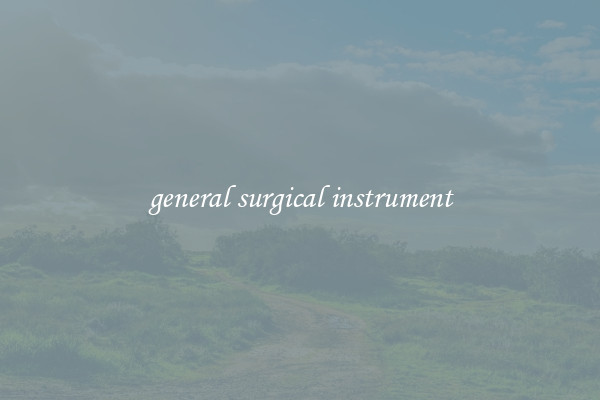general surgical instrument
General Surgical Instruments: The Tools of Modern Medicine

General surgical instruments are an essential component of any operating room. These precision tools are used by skilled surgeons and their team to perform a wide range of surgical procedures with utmost accuracy. From simple incisions to complex organ resections, these instruments are designed to assist in the successful outcome of surgical interventions.
One of the most common surgical instruments is the scalpel. This small, sharp knife with a flat, thin blade is used for making precise incisions. It allows surgeons to cut through skin, muscles, and other tissues with minimal trauma and bleeding. The handle of the scalpel is usually made of stainless steel, ensuring durability and sterility. Scalpels are available in different sizes and shapes, allowing surgeons to choose the most appropriate one for each procedure.
Another essential instrument in general surgery is the forceps. These hand-held metal instruments are used to grasp and hold tissues, blood vessels, and other structures during a surgical procedure. Forceps come in various shapes and sizes, with each specialized for a particular use. For example, hemostatic forceps have interlocking teeth or ridges on the tips that provide a secure grip on blood vessels to control bleeding. Tissue forceps, on the other hand, have smooth, serrated, or delicate teeth to handle different types of tissues.
Clamps are also widely used in general surgery. These instruments are designed to control bleeding by compressing blood vessels or to secure tissues in place during an operation. Depending on the purpose, clamps can be straight, curved, delicate, or heavy-duty. They come with ratchet locks to ensure a secure and precise grip. Commonly used clamps include the mosquito clamp, Kelly clamp, and bulldog clamp.
Surgical scissors are another set of crucial instruments used in general surgery. These scissors have long, slender blades with sharp or blunt tips, depending on the intended use. They are used to sever tissues, cut sutures, and dissect delicate structures. Different styles of surgical scissors are available, such as straight, curved, or angled, allowing surgeons to work with ease in different areas of the body.
Lastly, retractors play a significant role in general surgery. These instruments are used to hold open incisions or wounds, providing surgeons with an unobstructed view and access to the surgical site. A self-retaining retractor stays in place once it is positioned by a surgical assistant, while handheld retractors require manual holding throughout the procedure. Retractors come in various sizes and shapes to accommodate different body contours.
In conclusion, general surgical instruments are critical for the success of any surgical procedure. These precision tools allow surgeons to perform their work with accuracy, precision, and minimal trauma to the patient. From scalpels and forceps to clamps, scissors, and retractors, each instrument has a specific purpose and is designed to facilitate specific tasks during surgery. The continual advancements in surgical instruments and technology have greatly contributed to the advancement of modern medicine, enabling surgeons to achieve better outcomes and provide effective treatment to patients.

View details

View details

View details

View details




